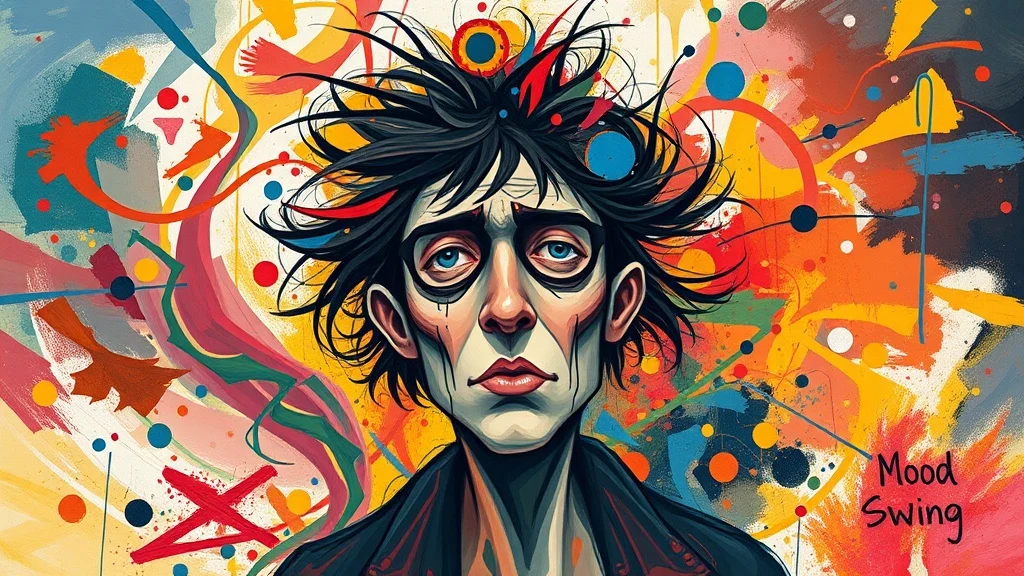10 Enigmatic Dream Symbols That May Hint at Bipolar Disorder
Want a Personalized Dream Interpretation?
Curious about what your dream symbol means in different contexts? Explore interpretations crafted for your unique scenario—free and personalized!
Get Free Interpretation Now →Table of Contents
1. Dream of Mood Swings
Mood swings are a common symptom of bipolar disorder, and they can be a source of great distress for people who experience them. Dreaming of mood swings can be a way for the subconscious mind to process these emotions and experiences.

The dream may involve sudden shifts in mood, from extreme happiness to deep sadness. The dreamer may feel like they are on an emotional roller coaster, with no control over their feelings. The dream may also involve feelings of anxiety, depression, or irritability.
Dreams of mood swings can be a sign that the dreamer is struggling to manage their emotions. They may be feeling overwhelmed by their symptoms, or they may be trying to suppress them. The dream can be a way for the subconscious mind to express these feelings and to help the dreamer to process them.
If you dream of mood swings, it is important to talk to your doctor. They can help you to understand your symptoms and develop coping mechanisms. They may also recommend medication or therapy to help you manage your condition.
2. Dream of Mania
In a dream of mania, the dreamer experiences heightened excitement, energy, and euphoria. This can manifest in the dream through:
- Grandiose plans: The dreamer may have ambitious ideas and plans, feeling unstoppable and capable of achieving anything.
- Elevated speech: The dreamer may speak rapidly and excitedly, often with grandiose gestures.
- Increased physical activity: The dreamer may be restless, pacing, running, or dancing excessively.
- Irresponsibility: The dreamer may make impulsive decisions or engage in risky behaviors without regard for consequences.
- Hallucinations or delusions: In extreme cases, the dreamer may experience sensory hallucinations or grandiose delusions of power or invincibility.
These dream symbols reflect the heightened state of mind and grandiose self-perception associated with mania in bipolar disorder. The dreamer may feel invincible and euphoric, but it's essential to be aware that these symptoms can also indicate an underlying mental health condition that requires professional attention.
3. Dream of Hypomania
If you dream you are hypomanic in your dream, it suggests that you are feeling creative and motivated.
You are likely to have many new ideas and be able to execute them quickly. This is a good time to start new projects and take risks. However, it is important to be aware of the potential dangers of hypomania, such as impulsivity and irritability. If you start to feel out of control, it is important to seek help.
4. Dream of Depression
Dreaming of depression is often a reflection of one's mental state during an episode of bipolar disorder. The dream may feature feelings of hopelessness, worthlessness, and lethargy. The dreamer may also experience difficulties sleeping, concentrating, or engaging in activities they once enjoyed. In some cases, the dream may include imagery of self-harm or suicide.
Upon waking, it's crucial to acknowledge these dreams as a manifestation of the disorder rather than a sign of impending doom. The dream is a reminder to seek professional help and engage in self-care practices to manage the symptoms of bipolar disorder.
5. Dream of Mixed Episodes
Mixed episodes in dreams reflect the extreme mood swings characteristic of bipolar disorder. These episodes often involve alternating periods of elevated mood (mania or hypomania) and periods of depression.
In such dreams, the dreamer may experience the following symbols:
- Rapid Shifts: Sudden transitions between joyous exuberance and overwhelming despair.
- Heightened Energy: Intense bursts of activity, racing thoughts, and reduced need for sleep.
- Grandiose Thoughts: Inflated sense of self-worth, grandiose ideas, and overconfidence.
- Impulsivity: Reckless behavior, impulsive spending, and engaging in risky activities.
- Erratic Emotions: Uncontrollable mood swings, alternating between euphoric highs and depressive lows.
- Sleep Disturbances: Difficulty falling or staying asleep, or excessive sleepiness.
- Difficulties Concentrating: Inability to focus, difficulty completing tasks, and rapid thought patterns.
- Feelings of Isolation: Detachment from reality, withdrawal from others, and a sense of being disconnected.
- Self-Destructive Behavior: Thoughts or actions that harm or endanger the dreamer, such as substance abuse or self-sabotage.
6. Dream of Rapid Cycling
Rapid cycling in dreams, characterized by alternating phases of mania and depression, symbolizes an inability to regulate emotions. It suggests a constant struggle to maintain stability, as the dreamer experiences intense highs and lows. The dream may reflect a lack of control over thoughts and feelings, leading to overwhelming emotions that cycle rapidly. This can indicate a need for external support, therapy, or medication to manage mood swings and restore emotional equilibrium.
7. Dream of Self-Harm or Suicide
Dreaming of self-harm or suicide can be a distressing experience. However, it is important to understand that these dreams do not necessarily mean that you are at risk of harming yourself or ending your own life. Bipolar disorder can cause extreme mood swings, and these mood swings can sometimes manifest in dreams. If you are experiencing dreams of self-harm or suicide, it is important to talk to your doctor or therapist about these dreams. They can help you understand what these dreams mean and provide you with support and resources.
8. Dream of Hospitalization
Dreaming of being hospitalized for bipolar disorder represents your inner struggles with mental health. The hospital symbolizes a place of safety and treatment, suggesting that you may be seeking help or support for your condition. The dream may also indicate feelings of isolation or loneliness, as you may feel disconnected from others who do not understand your experiences. It is important to remember that you are not alone and that there are resources available to help you manage your bipolar disorder.
9. Dream of Medication
Dreaming about taking medication can symbolize feelings of needing to control or manage something in your life. It can also indicate that you're feeling overwhelmed or under a lot of stress.
In the context of bipolar disorder, this dream could represent your attempts to manage your symptoms. It could also indicate that you're feeling like you're losing control of your emotions or thoughts.
Alternatively, this dream could be a sign that you're feeling better and are starting to gain a sense of stability in your life. It could also indicate that you're making progress in your recovery.
10. Dream of Therapy
In a dream of therapy, the dreamer may experience a variety of dream symbols related to bipolar disorder. These symbols can provide insight into the dreamer's current state of mind and the challenges they are facing.
One common dream symbol of bipolar disorder is the roller coaster. This symbol can represent the extreme mood swings that people with bipolar disorder experience. The dreamer may feel like they are constantly going up and down, with no control over their emotions.
Another common dream symbol of bipolar disorder is the storm. This symbol can represent the chaos and turbulence that people with bipolar disorder often feel. The dreamer may feel like they are being tossed around by their emotions, and that they have no control over their life.
Still another common dream symbol of bipolar disorder is the binary code. This symbol can represent the duality of bipolar disorder. The dreamer may feel like they are two different people, with one side being happy and energetic and the other side being depressed and lethargic.
These are just a few of the many dream symbols that can be associated with bipolar disorder. By understanding the meaning of these symbols, the dreamer can gain a deeper understanding of their condition and the challenges they are facing.
Back to interpretation of bipolar disorder

